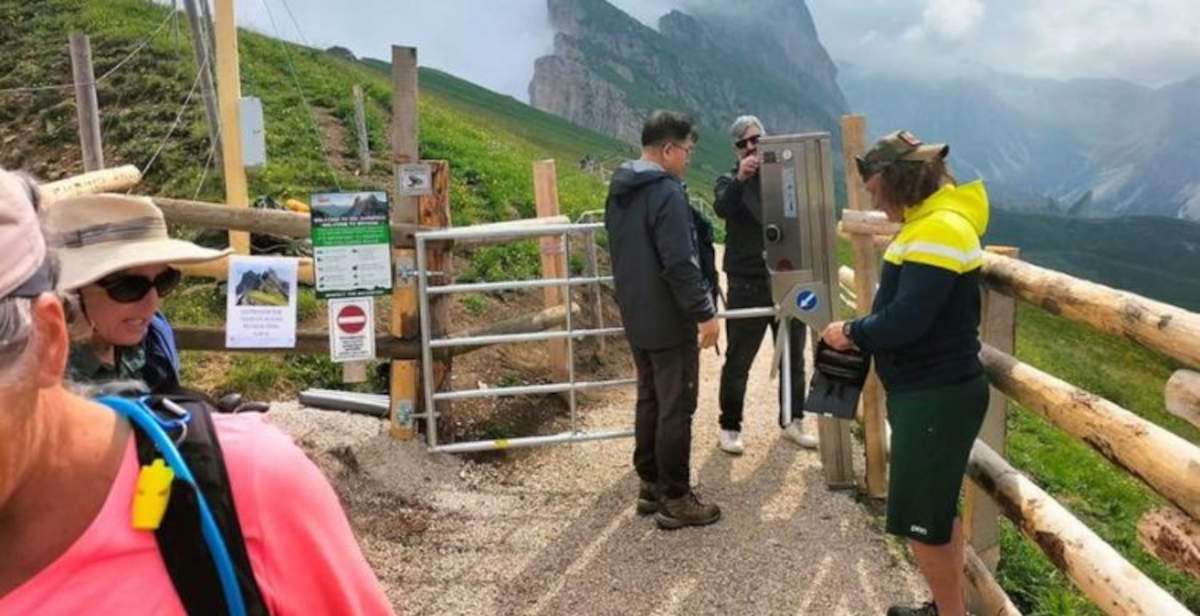It’s happening in Val Gardena (Bolzano province): four landowners, tired of seeing the siege of rude tourists at a scenic trail (that of Mount Seceda) that has become particularly well known thanks to an Apple campaign, decided of their own free will to install a turnstile at the entrance to the trail, from where one can photograph the peaks of the Odle, the Dolomite chain that marks the border between Val Gardena and Val di Funes. It happened last Saturday, July 5. The idea was to charge 5 euros for each tourist wishing to pass through the trail (in fact, photos had already appeared on social media with the sign reading "Entry for the famous rocks Seceda trail - 5.00 €). The turnstile was later removed even before it went into operation, reasoning that the action of the four owners was more of a form of protest, a provocation, than a tourism control initiative (or a way to monetize the trail), but it still caused much discussion.
“It was a half-day trial on Saturday, July 5, to test the reaction,” Georg Rabanser, a former Italian national team snowboarder and owner of a mountain meadow on Seceda, one of the four people responsible for the initiative, explained to the Ladin-language magazine La Usc. “So many people come through here every day, everyone goes through our properties and leaves trash,” he added. And of course then the meadow owners have to clean up. For years, he told the press, the Seceda landowners have been asking the province and the tourism companies to do something, and to Corriere della Sera, which interviewed him, Rabanser said that everyone recognizes that compensation is needed for those who take care of the mountain meadows and trails, but so far nothing has been done. They had also asked that they be given a fraction of the expensive Seceda lift ticket (10 cents out of 52 euros), but this could not be done. And the problems for residents remain.
In fact, the Seceda trail is heavily traveled by tourists: in high season there are hundreds of people who walk it every day (on peak days, Rabanser said, it can be as high as 5-6 thousand). The trail’s popularity dates back to an Apple presentation at a conference in 2017 that projected images of the Odle and Seceda, which have since become particularly popular, onto the iMacs of attendees. A popularity then also fueled by the effect of social media. So much so that the president of the South Tyrolean CAI, Carlo Alberto Zanella, attributes the problems of overcrowding on the Seceda trail mainly to the latter. In fact, Zanella took to his Facebook profile to comment on the initiative of Rabanser and the three other landowners: “News from Val Gardena: now you also pay tolls on the trails. One of the most photographed trails in the Dolomites invaded by tamers, Influencers, YouTube and instagrammers. The result of a politically wanted form of tourism as well.”

Zanella, interviewed by the local newspaper Salto, called the initiative a useful provocation because “it serves to bring a real problem to public attention. A lot of people cross the meadows, bikes go through them, they spoil the fields before mowing, and farmers with those meadows live there, they have to make hay with it, sell it. And then picnics everywhere, people lounging. It’s not trivial. You need education, education to respect the environment. That’s the point.” Added to this is the issue of liability: Zanella recounted how a tourist, in order to take a selfie, took a head butt from a cow, ended up in the hospital, and sued the farmer.
The land along the trail is in fact private, and in theory the farmers could also close it or decide to restrict entry. But, Rabanser said, this is not what the owners want: their goal is to activate a table with the province and tourist associations to make sure that both the needs of tourism and those of residents can find a balance.
This initiative thus comes at a time of increasing tension between the need to protect the alpine environment and the pressure of increasingly massive tourism. The targeted trail is a place that has undergone a great deal of media exposure in recent years, becoming a favorite destination for content intended for social media. Indeed, the pressure on these trails has increased exponentially in recent years. Accomplicated by social networks, platforms such as Instagram and YouTube have contributed to the widespread dissemination of images depicting striking views of the Dolomites, transforming the places into must-see destinations for influencers, aspiring photographers, creators, and tourists attracted by the spectacular nature of the landscape. The consequence? A progressive loss of control over the influx of visitors, which in some cases has compromised the environmental balance and serene access to the trails. The phenomenon therefore brought with it a change in the profile of the public as well: no longer just trained hikers or mountain enthusiasts, but also simple frequenters in search of the perfect image, often ill-equipped or unaware of the natural context in which they move. The transformation has been fostered by a tourism model that has focused on increasing media visibility.
The toll debate will of course continue, although everyone says it will not be decisive. While it is proposed as a tool for regulating access and protecting the environment, it also raises questions about the direction taken in terms of tourism management and the political responsibilities that helped create the current environment.
 |
| "Invaded by tamarins and influencers," and in protest the turnstile pops up on the Dolomites trail |
Warning: the translation into English of the original Italian article was created using automatic tools. We undertake to review all articles, but we do not guarantee the total absence of inaccuracies in the translation due to the program. You can find the original by clicking on the ITA button. If you find any mistake,please contact us.